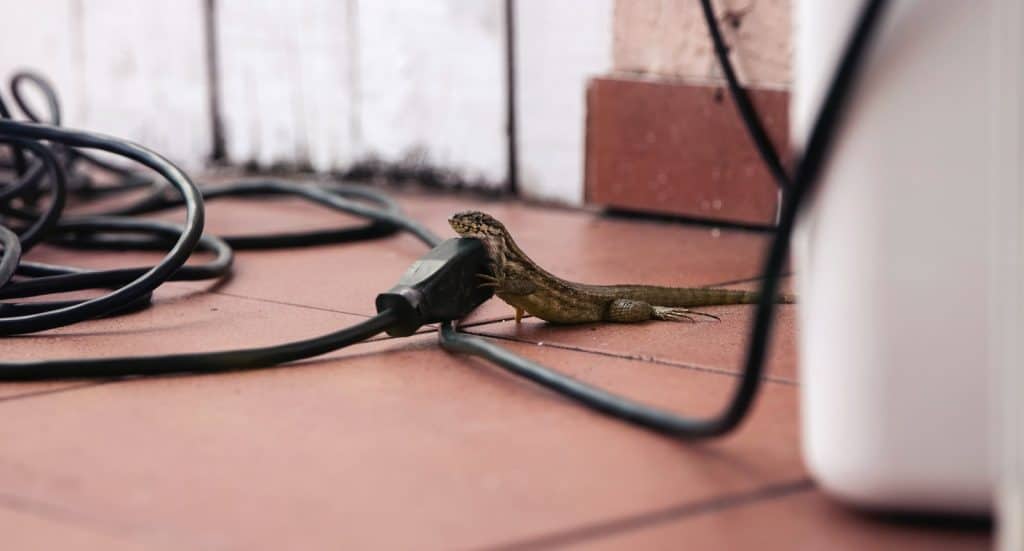Wondering how to hide outdoor cables? Cables are a pain to maintain, and they create an eyesore even if they run in straight, neat lines. Wires for cables may be more challenging to hide outdoors than wires for electricity since they are more prone to wear and tear and there are fewer ingenious locations to conceal them.
So, whether you’re upgrading your pool’s pump or setting up a security camera, here are some pointers on where on how to hide outdoor cables or cover exposed wires.

How to Hide Outdoor Cables: Easiest Ways
If you don’t have much cord to run or are putting cables directly on your home’s exterior wall, there are several ways on how to hide outdoor cables. Matching or hiding the exposed wiring with the wall color or simply running them behind the walls themselves is another option.
Even if your wires are fully covered, remains vigilant by using only waterproof wires and extension cords. Though it may seem innocuous, water can seep through any crevice or crack and cause major malfunctions or short circuits. Taking this extra step will give you the peace of mind that comes with knowing your devices are protected from potential damage.
Painting Your Cable Wires or Cable Raceway
Consider painting or the tubing they are housed in to match the exterior color if your cable wires will be attached to the outside of your home. For the best coverage, take a chip from your house’s paint and bring it to any paint shop. Painting your cables not only helps them blend in, but it also prevents UV ray damage.
To paint your wires, you will need a sponge, outdoor spray paint primer, and outdoor paint that matches. You should also get a refillable painting spray gun. Follow these steps how to hide outdoor cables:
- Before doing anything else, use a light sponge to clean the length of the wiring. This will make it easier for the paint to stick and prevent it from smearing.
- The primer spray should be sprayed over the length of your cable.
- To mix canned paint, use a 1:9 ratio of water to paint. Pour the mixture into the spray gun, and coat your cable wire.
Some cable raceways are also pre-treated for chemical or UV exposure in addition to being waterproof. If you can, try to get them in a color that is as close to your home’s as possible to save time.
In our specific case, we’re adding a sizable outdoor kitchen and need to have electricity set up for it. Additionally, we added a ceiling fan and now need to find a way to cover up the unsightly wires.
Cable Wire Ground Protector
If your main concern is protecting your cables from being damaged, purchase a floor cable raceway. These are made of plastic and come in various shapes and lengths.
Many raceways are thinner and run the length of the cord. Others are thicker and more durable, forming a kind of roof that a car could drive over. Choose one depending on the amount of versatility or protection your cable wires require.
Cable Boxes
If you have a lot of wires cluttering up your home and looking unsightly, consider investing in a cable box to hold the excess. A basic plastic and waterproof box or a drilled cable wire housing receptacle into the side of your property are two options. This box can also be painted to blend in with your house’s color.
How to Hide Outdoor Cables: Hiding Cable Wires On Your House
If your electric device will be attached to your home, you can use the following house designs to make life easier:
Look out for these features:
- Walls
- Deck
- Roof overhangs
- Siding panels
You may conceal your cable wires beneath the eaves of a house with overhangs, stapling them into the side of the property; however, you should still use a cable tube or wire guard for additional protection. Hiding your cable wires within the lip of a home’s side panel is very similar.
You may also drill holes into your walls to run cables behind or simply run your cable wires along the bottom or vertical edges. This electrical practice is particularly beneficial for security cameras that just require a tiny hole drilled in the siding so you can then connect the power and ethernet cables inside.
How to Hide Outdoor Cables: Hiding Cables in Your Yard
The only way to effectively hide extension cords is by burying them underground. This applies whether you’re installing a pond, fountain, or other type of lighting in your yard.
The depth you will need to dig depends on the type of soil and how much cable you need to run. For example, if you have tough ground, you may only need to dig six inches deep. On the other hand, if the soil is light and less dense, you will be able to digging farther down. In addition, burial depth affects conduit cost—the deeper you bury your exposed wires, the cheaper the conduit.
How to Hide Outdoor Cables: Choosing Cable Wire Conduits for Digging Underground
The following table can act as a starting guide to help you determine which conduit material is best suited for your needs, based on the depth of the cable.
Cable Depth6 inches12 – 24 inchesConduit MaterialRigid Metal Conduit – Galvanized SteelPVC Pipe
Steel is utilized for shallower depths in order to avoid the conduit and wire from melting in the event of a fire or explosion, as the damage from each may extend below ground.
Depending on the type of cable and depth, PVC pipe may not be necessary past 6 inches. Consult an expert or investigate the kind of coating your wires have, for example:
- Thermoplastic High Heat-resistant Nylon-coated (THHN)
- Ground-Fault Circuit Interrupter protection (GFCI)
How to Hide Outdoor Cables: Hiding Temporary Cables
If you are only going to have your wires for a few months, consider some less time-consuming methods for concealing them, both for protection and beauty.
While it may not appear to be as essential to conceal temporary cables, doing so may be a good idea, especially if you want your installation to look as attractive as possible.
How to Hide Outdoor Cables: Match Your Cable Colors
Cables and extensions electrical cords are generally colored to blend in with the decor. If you don’t know what kind of cable or extension cord to get, consider where you’ll be putting your wires. Here’s a simple guideline:
Consider if you will be doing any yard work in the meantime when mixing your wires in with the environment. If you have a weed-whacker or a lawn mower, don’t place cable wires there because they might get caught up in it or cut into it.
For a quick-term solution, consider installing a cable runway for the ground in areas with heavy foot or vehicle traffic.
How to Hide Outdoor Cables: Hiding More Heavy-Duty Cable Wires
If you want to bury more industrial-grade wiring, there are a few things to think about.
- Cable weight
- Cable length
- Cable strength
If you’re running heavier or more numerous cables alongside an outdoor structure, you’ll want a steel cable runway system that’s larger in size. Steel brackets can be used if your wires are adequately shielded from corrosive damage, but fiber optic cables will require the use of steel tube protection.
How to Hide Outdoor Cables- Bottom Line
The best way to hide outdoor extension cords will vary depending on the type of garden project you’re working on, how long you need the cables, and the tools and materials you have available.
For a quick-term solution, try matching your cable colors to your environment or using a cable runway. If you need a more permanent solution, consider hiding your cable wires underground in PVC pipes.
No matter what method you choose, make sure to take safety precautions to avoid any accidents.


